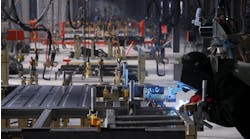By Christine Feuell, Chief Marketing Officer of Honeywell Intelligrated
Automation has been a major buzz word in supply chains for many years, but the COVID-19 pandemic has ushered in a heightened need for stronger supply chains and automated systems, particularly in warehouses, distribution-and-fulfilment centers, and customer-service roles. Amid the pandemic, supply chain issues like empty shelves and shipping delays could be lessened by greater adoption of warehouse automation.
And while there are fears that robots will replace jobs, automation has the potential to create new and different jobs and career growth for employees. In fact, two in three companies see opportunities for automation to create new and different jobs within distribution centers and warehouses in customer service, technical support, maintenance and operations management, according to a recent Honeywell survey. Plus, eight in 10 companies see opportunities for automation to create new jobs in maintenance roles.
Let’s explore why…
Filling the labor shortage
In the growing supply chain industry, labor demand outpaces the labor pool by a six-to-one ratio. This labor gap could leave as many as 2.4 million positions unfilled between 2018 and 2028, according to a report by Deloitte and The Manufacturing Institute. The gap can be attributed both to existing workers retiring out of jobs and the accelerated growth of the e-commerce industry.
As the Baby Boomer generation closes in on retirement, younger generations often lack the skills or desire to fill vacated roles. Despite the shrinking skilled-labor pool, however, there is no corresponding reduction in demand, especially in the growing e-commerce industry. The COVID-19 pandemic has only accelerated growth, with e-commerce sales expected to reach nearly $800 billion this year, an increase of 32.4% from 2019.
The skills gap results in workers taking on more than they can handle, forcing them to take on monotonous duties and limiting their job growth and career development. Automation can not only help fill this gap but can create opportunity for safer and more skilled work.
Making jobs safer
Automation software and decision-intelligence tools have the potential to make warehouses safer for all employees by consistently monitoring for issues and quickly alerting managers whenever an issue is detected.
Warehouse employees are often tasked with dangerous and physically demanding jobs. For example, unloading packages in distribution centers is both labor-intensive and injury-prone work. Plus, distribution-center workers tasked with unloading are sometimes subjected to extreme temperatures. However, automated systems can take over these undesirable duties, allowing workers to remove themselves from dangerous situations and take on more fulfilling work, improving both employee satisfaction and turnover rates.
Expanding worker skillsets
With automation taking over mundane, time-consuming, and even dangerous tasks, warehouse employees are able to focus their time on more skilled duties, such as the strategy, maintenance, and oversight of these technologies. Automated systems require frequent maintenance and care, because poor maintenance can lead to major meltdowns in operations and costly downtime. As such, humans are needed to monitor and evaluate disruptions before aligning on a solution.
Let’s face it: automation is here to stay. More than half of companies are more willing to invest in automation now as a result of the pandemic, survey data shows. Now is the time for companies and their employees to work together to embrace automation and the benefits it can bring in terms of supplementing and enhancing human jobs in our supply chain.


